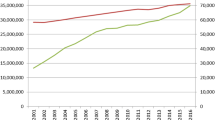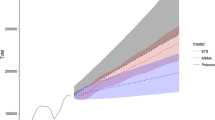Abstract
Background
In 2012 and 2013 Austria had the highest rate of primary total knee replacements (TKR) amongst all European countries. This study was carried out to project the numbers of TKR and its associated costs in Austria into the year 2075.
Methods
Demographic data and population projections between 2011–2075 were obtained from European and Austrian authorities. Information about the present incidence of primary TKRs was obtained from the Austrian Prosthesis Register. Current TKR associated costs were obtained from federal healthcare insurances as well as federal and state admission agencies. Projections were stratified by age and gender and given for the lower, most likely and upper scenarios.
Results
Overall cost for the group of patients with primary TKR will increase by 50% for males and 32% for females by 2075. This increase is primarily driven by the increase in the population of men aged 80–90 years and 90+ years leading to an increase of 190% and 567% of the TKR associated costs. In comparison, women in these age groups are estimated to have an increase in TKR costs by 108% and 243%.
Conclusion
These numbers represent a substantial socioeconomic burden to the Austrian society in the near and distant future due to the upcoming demographic changes. The presented results have their limitation in the unpredictable nature of assumptions but might guide Austrian and other European authorities in their efforts to provide more cost-effective and more directed care for patients in need of primary TKR surgery.
Zusammenfassung
Hintergrund
In den Jahren 2012 und 2013 hatte Österreich von allen europäischen Ländern die höchste Rate an primären Knietotalendoprothesen (Knie-TEP). Diese Studie wurde durchgeführt, um die Anzahl der Knie-TEP und die damit assoziierten Kosten bis zum Jahr 2075 abzubilden.
Methoden
Demographische Daten und Bevölkerungshochrechnungen zwischen 2011 und 2075 wurden von den europäischen und österreichischen Behörden eingeholt. Informationen bezüglich der aktuellen Inzidenz primärer Knie-TEP wurden bei den gesetzlichen Krankenversicherungen sowie staatlichen Zulassungsbehörden angefordert. Die Hochrechnungen wurden nach Alter und Geschlecht stratifiziert, wobei jeweils das geringste, wahrscheinlichste und das höchste Szenario berechnet wurde.
Ergebnisse
Die Gesamtkosten der Patientengruppe mit primärer Knie-TEP werden bis 2075 um 50 % (Männer) und 32 % (Frauen) ansteigen. Dieser Anstieg wird hauptsächlich durch die wachsende Anzahl der männlichen Bevölkerung im Alter von 80–90 und über 90 Jahren angetrieben, was zu einem Anstieg der Knie-TEP-assoziierten Kosten von 190 % und 567 % führt. Im Vergleich dazu verzeichnen Frauen in diesen Altersgruppen einen Anstieg der Knie-TEP-Kosten von 108 % und 243 %.
Schlussfolgerung
Diese Zahlen stellen eine erhebliche sozioökonomische Belastung für die österreichische Gesellschaft in der nahen und fernen Zukunft aufgrund des demographischen Wandels dar. Die Limitation der vorgestellten Ergebnisse liegt darin, dass die berechneten Abschätzungen nicht mit 100 %-iger Genauigkeit und sicher vorauszusagen sind; sie können jedoch die österreichischen und anderen europäischen Behörden in ihren Bemühungen unterstützen, eine kosteneffizientere und gezieltere Versorgung für Patienten zu gewährleisten, bei denen eine Knie-TEP-Operation notwendig ist.

Similar content being viewed by others
Abbreviations
- IRB:
-
Institutional Review Board
- ME:
-
Million Euros
- OA:
-
Osteoarthritis
- OECD:
-
Organization for Economic Cooperation and Development
- TKR:
-
Total knee replacement
References
WHO (2014) Chronic Rheumatic Conditions, Fact Sheet
Losina E et al (2012) The dramatic increase in total knee replacement utilization rates in the United States cannot be fully explained by growth in population size and the obesity epidemic. J Bone Joint Surg Am 94(3):201–207
OECD (2015) Health at a Glance 2015: OECD Indicators. OECD Publishing, Paris
OECD (2014) Health at a Glance: Europe 2014. OECD Publishing, Paris
Tukker A, Visscher TL, Picavet HS (2009) Overweight and health problems of the lower extremities: osteoarthritis, pain and disability. Public Health Nutr 12(3):359–368
Gesundheit B (2016) Häufigste operative medizinische Leistungen bei stationärem Aufenthalt 2014
Francette Koechlin PK, Lorenzoni L, Schreyer P (2014) Comparing hospital and health prices and volumes internationally results of a Eurostat/OECD project. OECD health working papers
Helmick CG et al (2008) Estimates of the prevalence of arthritis and other rheumatic conditions in the United States. Part I. Arthritis Rheum 58(1):15–25
Massie BM, Shah NB (1997) Evolving trends in the epidemiologic factors of heart failure: rationale for preventive strategies and comprehensive disease management. Am Heart J 133(6):703–712
Weinstein AM et al (2013) Estimating the burden of total knee replacement in the United States. J Bone Joint Surg Am 95(5):385–392
Nuesch E et al (2011) All cause and disease specific mortality in patients with knee or hip osteoarthritis: population based cohort study. BMJ 342:d1165
Seil R, Pape D (2011) Causes of failure and etiology of painful primary total knee arthroplasty. Knee Surg Sports Traumatol Arthrosc 19(9):1418–1432
Author contributions
All authors participated in the research leading to the results presented in this manuscript and assure that the manuscript is not under simultaneous consideration by any other journal.
Author information
Authors and Affiliations
Corresponding author
Ethics declarations
Conflict of interest
W. Hitzl, S. Heisinger, G.M. Hobusch, K. Frank and S. Cotofana declare that they have no competing interests.
Institutional Review Board (IRB) approval was not required.
Rights and permissions
About this article
Cite this article
Hitzl, W., Heisinger, S., Hobusch, G.M. et al. Projected numbers of primary total knee replacement in Austria from 2015–2075. Orthopäde 48, 144–149 (2019). https://doi.org/10.1007/s00132-018-3605-9
Published:
Issue Date:
DOI: https://doi.org/10.1007/s00132-018-3605-9




